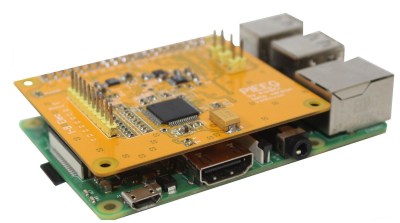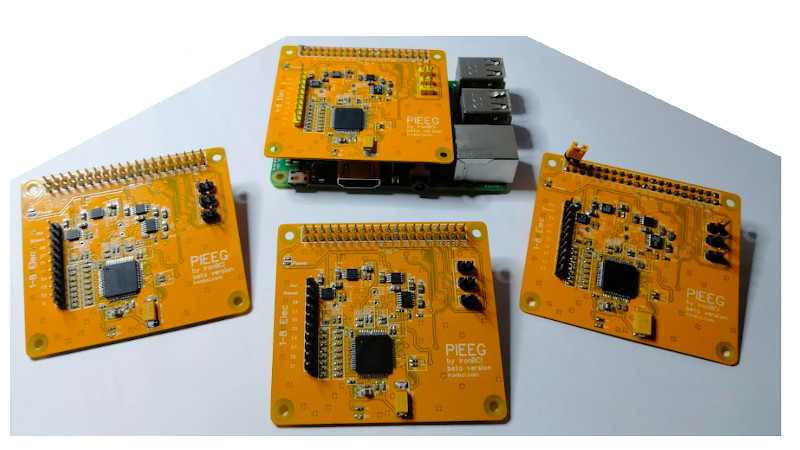PiEEG offers an affordable brain-computer interface
One day in the future, we might interact with our electronic devices not with physical input or even voice commands, but simply by thinking about what we want to do. Such brain-computer interfaces (BCIs), combined with machine learning, could allow us to bring our ideas to life faster and with less effort than ever before - imagine being able to produce a PCB design just by thinking about how the completed circuit would work. Of course, as an assistive technology, BCIs would change nothing less than the lives of many.
 Today Today BCI is still in its infancy, but that doesn't mean there isn't room for hackers and makers to experiment with the concept. [Ildar Rakhmatulin] has been working on low-cost, open-source BCIs for years, and with the recent release of his PiEEG on Crowd Supply, believes he has finally found an affordable solution that will allow individuals to experience this advanced technology.
Today Today BCI is still in its infancy, but that doesn't mean there isn't room for hackers and makers to experiment with the concept. [Ildar Rakhmatulin] has been working on low-cost, open-source BCIs for years, and with the recent release of his PiEEG on Crowd Supply, believes he has finally found an affordable solution that will allow individuals to experience this advanced technology.
Implemented as a shield that can be connected to a Raspberry Pi 3 or 4, the PiEEG has 8 channels to connect wet or dry electrodes that can measure biosignals such as those used in electroencephalography (EEG), electromyography ( EMG) and electrocardiography (ECG). With the electrodes connected, reading these biosignals is as easy as running a Python script. Although primarily designed for neuroscience experimentation, [Ildar] says the device is also useful for learning more about signal processing, filters, and machine learning.
As of this writing, the Crowd Supply campaign has already reached 300% of its goal, and with a production plan in place that should get the material into the hands of backers before the end of the year, it looks like we won't have to wait too long to see what the community can do with this material. While the hardware seems locked down, [Ildar] says work on the software samples and documentation is underway on the project's GitHub repository. This already includes instructions on how to make your own dry electrode EEG measurement cap and a Python script that allows the user to operate a remote control toy by blinking.

One day in the future, we might interact with our electronic devices not with physical input or even voice commands, but simply by thinking about what we want to do. Such brain-computer interfaces (BCIs), combined with machine learning, could allow us to bring our ideas to life faster and with less effort than ever before - imagine being able to produce a PCB design just by thinking about how the completed circuit would work. Of course, as an assistive technology, BCIs would change nothing less than the lives of many.
 Today Today BCI is still in its infancy, but that doesn't mean there isn't room for hackers and makers to experiment with the concept. [Ildar Rakhmatulin] has been working on low-cost, open-source BCIs for years, and with the recent release of his PiEEG on Crowd Supply, believes he has finally found an affordable solution that will allow individuals to experience this advanced technology.
Today Today BCI is still in its infancy, but that doesn't mean there isn't room for hackers and makers to experiment with the concept. [Ildar Rakhmatulin] has been working on low-cost, open-source BCIs for years, and with the recent release of his PiEEG on Crowd Supply, believes he has finally found an affordable solution that will allow individuals to experience this advanced technology.
Implemented as a shield that can be connected to a Raspberry Pi 3 or 4, the PiEEG has 8 channels to connect wet or dry electrodes that can measure biosignals such as those used in electroencephalography (EEG), electromyography ( EMG) and electrocardiography (ECG). With the electrodes connected, reading these biosignals is as easy as running a Python script. Although primarily designed for neuroscience experimentation, [Ildar] says the device is also useful for learning more about signal processing, filters, and machine learning.
As of this writing, the Crowd Supply campaign has already reached 300% of its goal, and with a production plan in place that should get the material into the hands of backers before the end of the year, it looks like we won't have to wait too long to see what the community can do with this material. While the hardware seems locked down, [Ildar] says work on the software samples and documentation is underway on the project's GitHub repository. This already includes instructions on how to make your own dry electrode EEG measurement cap and a Python script that allows the user to operate a remote control toy by blinking.
What's Your Reaction?















![Three of ID's top PR executives quit ad firm Powerhouse [EXCLUSIVE]](https://variety.com/wp-content/uploads/2023/02/ID-PR-Logo.jpg?#)







